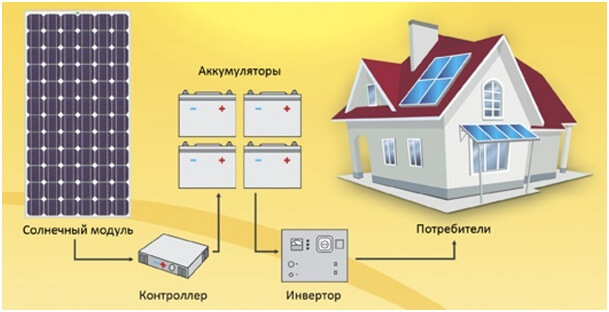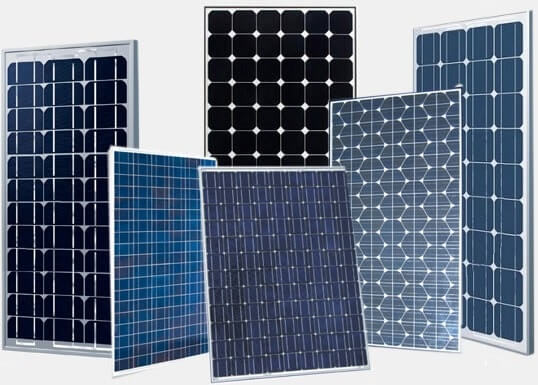Tips for choosing a solar battery and its components
What does the kit consist of?
To convert solar heat into power for electrical appliances, it is necessary to mount a complex that consists of such equipment:
- the panel, the solar battery itself, collecting rays;
- battery charge controller - battery efficiency depends on this component;
- rechargeable batteries - accumulate an electric charge, the duration of the autonomous mode depends on them;
- inverter - converts direct voltage to alternating voltage, which is supplied to household appliances.
In order for the autonomous power supply system to work as long and efficiently as possible, it is necessary to select components that, according to their technical capabilities, correspond to each other and the power consumption.
Selection tips
To choose the right solar panel, you need to consider many factors. First you need to determine the type of battery, but they are:
- Monocrystalline - are most effective in regions where solar activity is higher.
- Polycrystalline - it is recommended to use them where the activity of the Sun is not too high.
- Flexible - the panel is made of amorphous silicon and is intended for fixing on sloping, uneven surfaces, for example, roofs of houses. This type of performance is an excellent option for regions where sunny days are very rare. This variety is the cheapest and it is recommended to use it for a summer residence.
- A micromorphic silicon solar battery is a universal variety that works equally effectively in cloudy and clear weather, is not demanding on the angle of inclination. This latest development, respectively, and its cost is higher than previous varieties.
For efficient operation, the panel must have an optimal angle of inclination in order to capture solar energy. It is believed that the optimum indicator here is an angle of 15º more than geographical latitude. But not everyone can calculate this, therefore, the choice of the optimal position is carried out manually, by monitoring the charging of the batteries.
The choice of a solar battery in terms of power must be carried out based on the needs for alternative electrical power. Conventionally, this concept can be divided into 4 modes:
- Emergency power supply - it is necessary to calculate the total power of the devices that are needed if the power supply is turned off. This is often 4–5 kW / h. Usually this mode is done for heating and backup lighting.
- Basic power supply is an almost complete substitution of solar electric energy.Here, in order to choose the right characteristics, you need to calculate the daily intake. It is also necessary to take into account monthly average indicators.
- Moderate or comfortable mode. When an alternative source of electricity sits only part of the devices. Often this is a TV, kettle, range hood. Less commonly, microwave ovens, electric panels, ovens, or refrigerators.
- The mode of complete replacement of electricity. Here, in addition to calculations, the main thing is to choose equipment that will manage to accumulate the necessary amounts of energy.
Actually, the choice of a solar battery comes down to determining its required area with certain needs for electricity supply. In other words, it is the ability to charge batteries. A solar battery, its power directly depends on the surface area, for example:
- The 290 × 350 × 25 battery has a power of 20W;
- 475 × 513 × 25 - 30W;
- 470 × 676 × 25 - 40W;
- 1650 × 991 × 35 - 280W.
There are a large number of sizes of solar panels, which greatly simplifies their selection. It also defines a wide variety of devices in terms of power.
The video below provides the technology for calculating the power of the system. We recommend watching the video, because he will help to make a choice:
Attention! It should be noted that choosing a solar panel is not enough, you need to choose the batteries that meet the needs of energy supply. They provide autonomy, so their charge should be enough for the night and for bad weather, when the efficiency of the panels is greatly reduced. Special blocks are assembled from several batteries.
How to choose a controller
It is important to choose the right controller for your autonomous power supply system. It ensures the efficient operation of batteries, which extends their useful life. The wrong choice entails a quick battery failure, which leads to the need to replace them.
There are 2 types of controllers:
- MRI - allows you to 100% efficiently use the energy intensity of chargers;
- PWM - utilizes the accumulated energy by only 80%.
The difference in the efficiency of charge development creates a difference in cost. MRI controller is 2-3 times more expensive than PWM. But the high cost is compensated by calculating the average annual performance of the system. Using a PWM controller will force you to add more batteries.
It is very important to consider power. It should exceed the maximum performance of the battery pack. PWM controllers should correspond in this part to the indicators of chargers. This will cause less energy loss during voltage conversion.
The expert opinion on how to choose a controller is provided in the video:
That's all I wanted to tell you about how to choose a solar battery for the home in terms of power and type of performance. We hope the information provided has helped you answer the question.
Useful on the topic:







